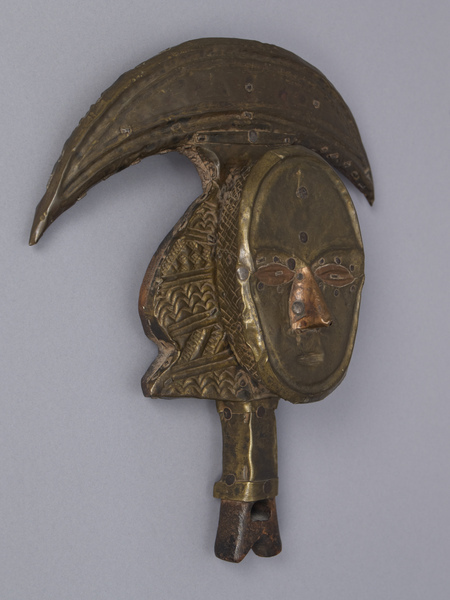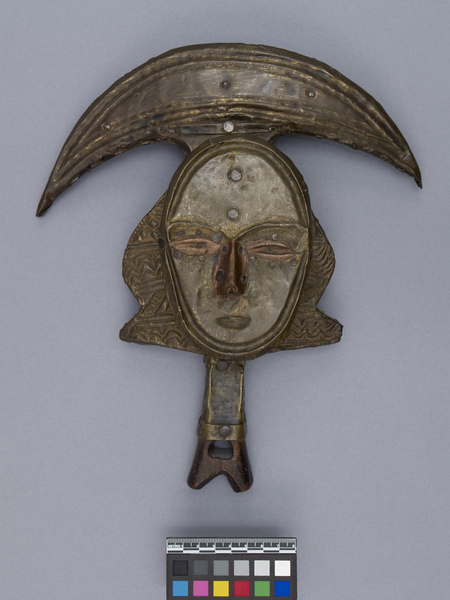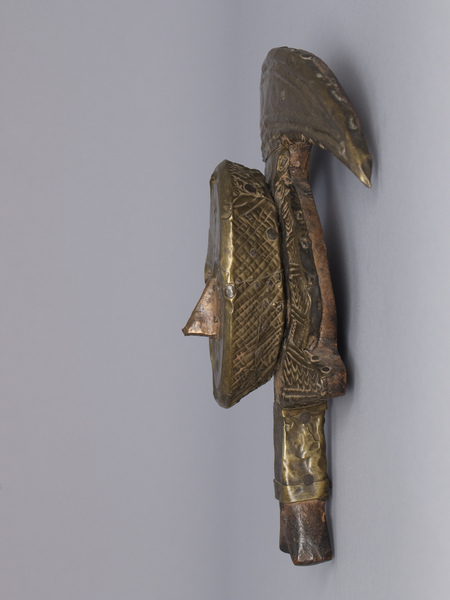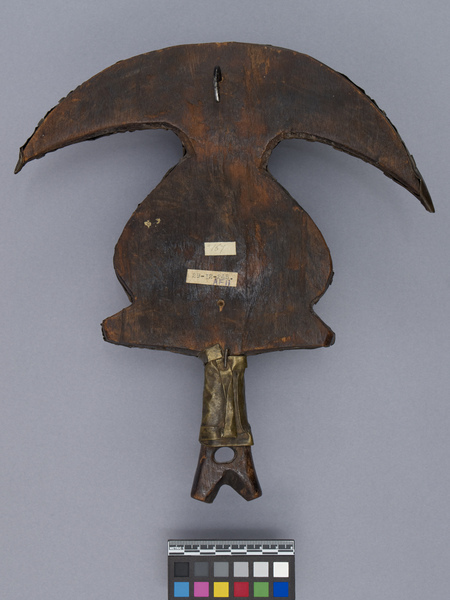Funerary Figure Item Number: 2815/2 from the MOA: University of British Columbia




Description
A funerary figure. The figure is made of wood, but the front is completely covered with metal sheeting. The sheeting is attached to the wood with nails and staples, and patterns and features have been pressed into it. The face is flat, with an emphasized brow, and the mouth is indented into the metal. Eyes and protruding nose are made of copper. Behind the face is a patterned back piece, above which is a crescent-shaped headdress. Below the face is a thin wooden piece partly wrapped with metal, the lower third is bare wood. A hole is carved into the uncovered wood portion, and the bottom of the piece is cleaved.
History Of Use
From the 18th to mid-20th century, Bakota groups have produced stylized and anthropomorphic reliquaries, meant to protect the remains of the ancestral dead. Rather than the reliquary representing the deceased themselves, the reliquary operated as a kind of guardian figure and conduit for others to address the ancestral dead. These reliquaries were affixed to baskets or bark boxes that contained the deceased’s remains and were often either part of reliquary ensembles or were stored in small shelters outside of village compounds. Bakota figures have two regional forms. The southern Bakota-Obamba produced mbulu ngulu, which have concave or convex faces framed by geometric projections representing coiffures. The northern Bakota-Mahongwe group produced bwete, which are concave leaf- or knife-shaped figures with a cylindrical crest. The wooden bases of both mbulu ngulu and bwete were adorned with copper and brass sheets obtained through trade with Europeans. The historic scarcity of these metals in 18th and 19th century Gabon signified the importance and value of reliquaries, as well as led to their association as prestige objects, indicating the wealth of the family to whom the reliquaries belonged. In the late 19th century many mbulu ngulu were appropriated as souvenirs by explorers, missionaries, and colonial officials; second wave of collecting occurred in the 1920s and 1930s by art dealers and others working within the modern art movement. The increased interest led many collectors to discard the bark boxes and baskets containing the remains of the mbulu ngulu and to circulate the reliquary figures as art work.
Cultural Context
Ancestral guardian figure.
Iconographic Meaning
The ladder-like motif on the lower halves of the geometric projections on the sides may symbolize the “ladder of death/generations.”
Item History
- Made in Haut-Ogooué, Gabon ?
- Owned by David Torontow and Dorothy Torontow before September 14, 2010
- Received from David Torontow (Donor) and Dorothy Torontow (Donor) on September 14, 2010
What
- Name
- Funerary Figure
- Identification Number
- 2815/2
- Type of Item
- figure
- Material
- wood, copper metal and metal
- Overall
- height 29.0 cm, width 25.7 cm, depth 7.5 cm
Who
- Culture
- Bakota
- Previous Owner
- David Torontow and Dorothy Torontow
- Received from
- David Torontow (Donor) and Dorothy Torontow (Donor)
Where
- Holding Institution
- MOA: University of British Columbia
- Made in
- Haut-Ogooué, Gabon ?
When
- Ownership Date
- before September 14, 2010
- Acquisition Date
- on September 14, 2010
Other
- Item Classes
- carvings & sculpture
- Condition
- good
- Accession Number
- 2815/0002